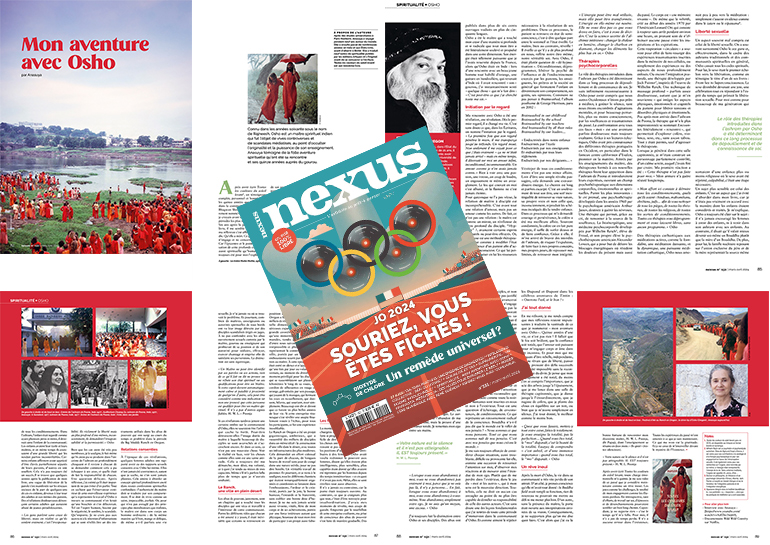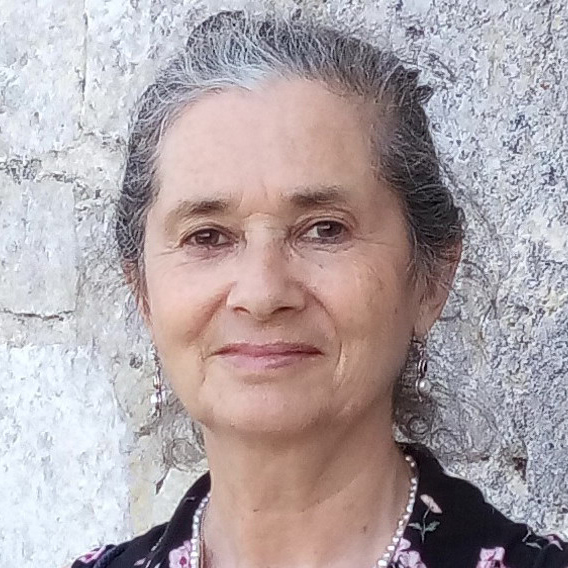Anasuya wrote an article for the French magazine Nexus, which published it in their March-April issue, No. 151. Here exclusively for Osho News the English translation

The world is nothing but my perception of it. I see only through myself. I hear only through the filter of my story.”
– Byron Katie
After writing All the Colors of the Rising Sun 1, a complete, personal and honest account of the fifteen years I spent in the spiritual community of Bhagwan Shree Rajneesh, later named Osho at his request, I thought I had said it all about one of the most intense periods of my life. Six years after the publication of my book, however, it seems to me that my thoughts have been refined and deepened. That they have matured. What I share with you is solely my own. For me, the epicenter and focus of this profound spiritual and human experience has always been self-exploration in all its facets. And not the multiple and contradictory conjectures about such a controversial figure as Osho.
For an insight into this community, unusual in its size, methods and teachings, there’s a documentary on Netflix, Wild Wild Country, which details the impact of this experience, but from a mainly outsider’s perspective. Unlike All the Colors of the Rising Sun, where I describe the particularities and workings seen from the inside, up close and personal. Therefore, there’s no need to repeat myself. However, there are a few points I’d like to return to or address.

First of all, Osho, the guru, the awakener of consciousness: a huge, original, controversial and eccentric figure whose revolutionary methods were often disparaged by the media and conservative minds of his time, from the 1960s until his death in January 1990. In my opinion, Osho was an authentic Tantric master: while he encouraged his disciples to live their sexuality – “All religions, including Christianity, repress your sexuality… I am against all forms of repression, for they all lead to perversion” – in reality, his teaching was essentially based on meditation, silence and inner immersion. Osho paved the way for what he called ‘the new man’, whose hallmark is the celebration of life in all its aspects and the vital center of his being, meditation. In his daily discourses, Osho spoke of numerous mystical traditions, such as Sufism, Buddhism, Tantra, Tao, Yoga, Zen, Hinduism, Christianity, Hasidism, etc., transcribed and published in over six hundred books translated into over fifty languages.

Osho was the master who touched my heart in such a profound and radical way that my whole being was literally lifted and propelled into another dimension. His energy was so powerful that I had felt it from France while Osho was in India: during a meeting with a handsome young man all dressed in orange, a guitar slung over his shoulder, who was returning from India where he had met ‘his’ guru, I instantly felt ‘something’ that made me say: “Maybe this is what I’ve been looking for all my life.”
Meeting Osho was a revelation, a revolution. From the very first glance, he changed my life. This is what the Scriptures call ‘initiation by look’. “The first time his gaze entered mine, it pierced me to the core. An unheard-of gaze. Not only did he see me for what I really was – it had never happened to me before – but at the same time, he poured out an infinite, unconditional, immeasurable love on me. Love like I’d never known.” Nothing like passion, intoxication, love at first sight, infatuation or even blindness. The fire that had been smoldering inside me was ignited, and the flame never went out.

For anyone who hasn’t experienced it, the master-disciple relationship is incomprehensible. First of all, it’s not a relationship: the master is like a mirror, revealing the disciple’s innermost being. Hypnosis? some would say, dubious or perhaps frightened. Hypnosis is a therapeutic method which involves altering a patient’s state of consciousness in order to access the unconscious. This enables the patient to draw on the resources needed to resolve his or her problems. In this process, the patient is placed in a state of semi-consciousness, i.e. somewhere between sleep and wakefulness. The master, on the contrary, awakens! He awakens what’s deepest within us, reflecting our very being, our true self. With Osho, it was more a question of dehypnotization. Deconditioning, deprogramming, freeing the psyche from the influence and indoctrination exerted by parents, teachers, priests and society in general, who format children by determining their behavior, tastes and opinions. Brainwashed, George Harrison’s posthumous album released in 2002, comes to my mind:
Brainwashed in our childhood
Brainwashed by the school
Brainwashed by our teachers
And brainwashed by all their rules
Brainwashed by our leaders…
Breaking free from all this conditioning is no easy task. Far from being a passing rebellion, it requires extraordinary energy. The path is long and sometimes steep. It’s an upheaval of the whole being, an inextinguishable thirst to rediscover one’s true nature, one’s own voice, and not the one that unconsciously reproduces the patterns inculcated from early childhood. In this process, which required courage and perseverance, anger was my best ally. Often condemned, anger is in fact pure energy: you just have to surf on it and trust it. Thanks to anger, I’ve defied ashram prohibitions, risked expulsion, confronted my own concepts and fears, pushed back my limits and rediscovered my integrity.
Energy can be misused, it can be transformed. Energy in itself is neutral. It will not tell you what to do with it – you have to decide. This is the secret science of inner alchemy: to change heat into light, to change coal into diamonds, to change baser elements into gold.”
– Osho

The role played by the therapies introduced into the ashram by Osho was decisive in this long process of starkness and self-knowledge. I’m infinitely grateful to Osho for having understood that we Westerners weren’t ready to meditate, to taste silence, so cluttered were we with mental agitation, and for many of us disturbed, more or less consciously, by past suffering and trauma. Confronting these false selves is a sometimes painful but always exhilarating adventure. Through his eclectic reading, Osho had become acquainted with the various therapies practiced in the West, in particular at the famous Esalen center in California, a pioneer in the field. Attracted by the master’s teachings, therapists trained in these new therapies appeared at the Poona ashram and introduced their expertise, opening up a psychotherapeutic field with bodily, emotional and spiritual dimensions. Among the most innovative:
Primal Scream, a psychotherapy developed in the 1960s by American psychologist Arthur Janov, designed to cure neurosis. This therapy uses the scream to trace the source of suffering. Bioenergetics, a mind-body medicine developed by Freud’s pupil Wilhelm Reich and his student Alexander Lowen, which aims to undo the energy blockages that are the source of present and past pain. The body is a ‘living memory’. The same is true of Rebirthing, created in the early 1970s by the American Leonard Orr, which involves breathing continuously for around an hour, taking care not to pause between inhalations and exhalations. This ‘circular’ breathing often has the effect of reviving traumatic experiences inscribed in the memory of our cells, or simply deeply buried experiences or aspects of ourselves. Or Postural Integration, a therapy developed by Jack Painter, inspired by the work of Wilhelm Reich, founder of mind-body therapy. A deep massage technique – sometimes quite painful, as I recall – that integrates the physical, emotional and cognitive aspects of the patient to release physical and emotional tensions and disorders. Shortly after my arrival at the Poona ashram, the therapy that most impressed me was called Encounter, which allowed the participants to explore anger, violence, sex, etc. without any taboos. Anything was permitted, except assaulting the therapist. By the time I entered the padded room, I’d constructed a perfectly controlled, serenely calm persona that I’d come to believe in. My first reaction was: “This therapy is not for me.” My armor didn’t last long.
My effort here is to destroy all conditioning – Hindu, Mohammedan, Christian, Jewish… it does not matter what kind of conditioning you are carrying; it is a weight. My therapies – and all the psychoanalytic methods used here – have a different purpose. It is to cleanse you of all traps, all theories, all religions, all kinds of conditionings. All these therapies here are deprogramming you and leaving you free, without any program.”
– Osho

From cathartic therapies to active meditations, such as Kundalini, a dancing meditation, and Dynamic, a powerful cathartic meditation, Osho gradually led us towards meditation: simply sitting in silence as in zazen or vipassana.
One aspect that is often misunderstood is sexual freedom. Osho has often been called a sex guru, and indeed, in the context of traditional ashrams and spiritual communities in general, Osho broke all spiritual codes. For him, sex was the first step towards liberation, as evidenced by the title of one of his books: From Sex to Superconsciousness. Uninhibited sex became a joy, a celebration, while at the same time responding to the spirit of the times, which advocated sexual liberation. For me, like many of my generation who had come out of a more or less religious childhood where sex had been repressed and made to feel guilty, it was a necessary step.
A more sensitive subject is that of children. It’s a subject I avoided tackling in my book, because I didn’t really agree with the way children were considered and treated in the ashram. Let me explain. Osho was always clear on the subject: he never encouraged women to have children, nor to come to his ashram with their children. On the contrary, he said it was better to become a Buddha oneself than the mother of a Buddha. Moreover, for him, the nuclear family based on the exclusive union of father and mother represented the very source of all conditioning. In the ashram, the child was considered to have several fathers and mothers, and thus became the child of the community. Children had their own school and their own teachers, and at the same time they enjoyed a freedom that sometimes made them uncontrollable. Some children claim to have appreciated being raised partially separated from their parents, but others suffered. It wasn’t always a success.

A few years after the publication of my book, a wave of outspokenness broke out on social networks from some of these ex-children, who now had become adults and parents themselves. Painful revelations denouncing certain adults for abusing young pre-adolescent girls.
People go on talking about freedom but what they really want is not freedom exactly; they want irresponsibility. They ask for freedom but deep down, unconsciously, they ask for irresponsibility and licence.”
– Osho
Although the cases were very few in number, I emphasize, the very fact that they could have occurred within the ashram grounds was deeply shocking, and left everyone to wonder how it could have escaped their notice, and what responsibility each of them actually bore. A delicate question. On reflection, I felt it was important not to avoid talking about it. All the while knowing that the outside observer of this marvelous experience represented by Osho’s work through his community would take a bite out of it and revel in it. Such is the human spirit, fascinated by the negative, the dark, the scandalous. Whatever. I don’t believe in secrets or withholding information, which has proven to be one of the instruments used in the abuses of power that have arisen over time and proliferated in the Oregon Ranch period.

This is not to be confused with openly sexual abuse committed by a master, guru or teacher who takes advantage of his or her position and authority to seduce, frighten, blackmail and hold others in order to satisfy his or her perversions. The distinction is unequivocal.
A Master cannot be identified through his words or his actions, nothing he does or says proves or disproves his spiritual state or his qualifications to be a Master. If your mind automatically becomes quiet and peaceful in the proximity of someone else, then that may be taken to be an indication (not a proof) that this person is qualified to be a spiritual teacher. There are no other reliable signs.”
– H.W.L. Poonja
If these late revelations cast a certain shadow over the Osho community, they cannot be the tree that hides the forest. Perhaps they destroy the golden image of the master to which many disciples have clung and still cling. And in that sense it’s not a bad thing. Facing reality, seeing things as they are is a healthy attitude. This has always been my approach, my desire, my will, what I have strived for to the best of my abilities. Although sometimes it took me longer than I would have liked.
The abuse of power, in fact, is a chapter that touched all the disciples who lived and worked within this community. Among the various roles that everyone was required to play, it was inevitable that some would find themselves in positions of authority. The Ranch in Oregon ended up counting several thousand people! A project of this magnitude required a great deal of expertise, but also a great deal of coordination.


© Samvado Gunnar Kossatz
The rise in power of those in charge of the community was so gradual that it’s hard to say at what precise point things got out of hand. Interestingly, all positions of authority were given to women. Osho had wanted to give power back to women, saying they were more intelligent, more sensitive, more capable, given that they had been repressed by men since time immemorial, in which he was not wrong. Alas, they turned out to be just as abusive.
There was never any compulsion, because the door was always open. On the contrary, what I feared most of all was being fired for insubordination. I had my moments of revolt, my outbursts. Carried away by the whirlwind of this enterprise that was overtaking us, my awareness of the abuse of power came gradually. There were definite signs, however: little by little, the fear of expressing myself freely, the lack of transparency, the withholding of information, the compartmentalization within the hierarchy, gave me the opportunity to observe the mechanisms of power. A lesson inscribed in my bones, once and for all: the essential difference between abandoning one’s ego and abandoning one’s responsibility. A lesson in discrimination.
Surrender or submission? Strangely enough, there is no adequate French translation for the English word ‘surrender’. Contrary to common belief, surrender is not for the fainthearted; it requires strength, lots of strength. In the spiritual realm, surrender is the act of abandoning one’s ego, which is based on total trust in the master. When I met Osho, I recognized in him the presence of the divine. I felt total love, a silence that overwhelmed me. Surrendering to him was not a surrender of responsibility, but a demonstration of total trust. I put my ego in his hands.
When you surrender to me you are not really surrendering to me, because I am not here… In fact, when you surrender to me, you surrender yourself. You don’t surrender to me. You simply surrender your ego. I am just a device, an excuse.”
– Osho
I’ve always made a distinction between Osho and his disciples. Abuses were committed by the disciples, not by the master. It would be unjustified to make an amalgam. I’ll even put forward a hypothesis of my own, although I’m not the only one to share it: Osho wasn’t unaware of what was going on in his community, so how could it have been possible? Even if he wasn’t endowed with clairvoyance, he couldn’t have been so ‘absent’ as to ignore the actions of the disciples in charge of his community, to the point of not inquiring about all the decisions taken in his name. Yet he hardly ever intervened. He let it happen. He let it happen in order to show us how far our own human tendencies, even the most dishonorable, could lead us. It would be too easy to blame: it’s not me, it’s the other guy, as the kids say. But it’s infinitely more revealing and liberating to turn our attention back on ourselves and recognize that all human beauty and darkness lie within us, not outside. It’s all a question of lighting, circumstances and conditioning. This represents a radical reversal of consciousness. Didn’t Buddha say that the world is a reflection of our thoughts? “We are what we think, all that we are arises with our thoughts, with our thoughts we make the world.”
I always tried to see every situation, however troubling, difficult or provocative, as an opportunity to turn the attention back on myself, to observe my reactions and thus measure the extent of my ego. Rather than losing myself in the outside world, in the game of ‘me and others’, which in my opinion is the wrong direction. However, this should never blind us to the point of no longer being able to disentangle our responsibility from that of the other players… This is undoubtedly one of the fundamental lessons I’ve learnt from this whole period of immersion in Osho’s community. And as the Dupond and Dupont in the famous Adventures of Tintin like to repeat: “Let’s keep our eyes open!”
Rereading myself, I realize that my reflections remain powerless to express the vastness of what I will call ‘my adventure with Osho’. Fifteen years of a lifetime is no mean feat! The fire had to be burning, the trust had to be total, the love had to be powerful to commit myself body and soul to this unknown. And for me, who prided myself on being rebellious, independent and dreaming only of freedom, going through the press of successive challenges would have been impossible without the recognition of the divine. I think my commitment was total, or at least I understood the importance of it, whether I was sawing trees to exhaustion, throwing myself into the padded room of a therapy room, dancing to the point of dizziness, roaring with anger, balancing nails on a roof, or simply sitting in silence. I gave everything, the best and the worst.
Whatever you do, just pour your heart in it, do it with totality. I teach you totality, not perfection… When you are total, the self disappears, that is the beauty of totality. Just try to understand – this is subtle, and of immense significance: when you are total, the self disappears.”
– Osho
After Osho’s death, life in his community quickly lost its appeal. On the one hand, I realized that it had given me everything: the Buddha field had served its purpose, nothing new could challenge me or take me further. On the other hand, without the master’s presence, the door was open to misinterpretations of his vision. As a result, I could no longer stand being told what to do. It was then that I had the good fortune to meet my second master, H.W.L. Poonja, known as Papaji, whose teaching can be summed up in two words: “Be quiet.”
Your nature is Silence and it is not attainable. It always Is.”
– Papaji

And I never cease to marvel at the mystery of Existence.
Anasuya
The original article was published by the French magazine Nexus in their March-April issue, No. 151. The English translation is by the author and is being published here with exclusive permission from Nexus: www.nexus.fr
Related notes, articles and links
- 1 All the Colors of the Rising Sun, published in 2018, is available on Amazon in paperback and digital formats. Read Sandhano’s review on Osho News
- All the Colors of the Rising Sun – Interview with Anasuya (in French with English subtitles): youtube.com
- Reviews by Osho News on the docuseries Wild Wild Country





Comments are closed.